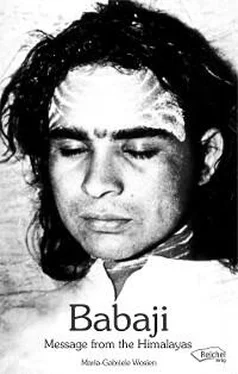So it can be seen how Shiva unites in himself on the one hand the point of absolute stillness and on the other hand the mighty, endless flow of dynamic energy that generates the infinite diversity of life. As cosmic Being: "his forehead is fire, the sun and moon his eyes, the four directions of space his ears, the Vedas his voice, the wind blowing through the world his breath, the earth his feet. He is the inner self of all things." 19
Depending on how spiritually evolved a person is, Shiva may reveal himself as 'Thou', and the abundance of myths handed down in the epic poems of the Mahabharata and Ramayana bears witness to this form as do also the experiences, visions and dreams of his devotees 20. In another way Shiva may reveal himself as knowledge born in the innermost depths of a human being and here the divine is experienced as the 'I am' in a process of becoming. Shiva may also be encountered in a personal relationship as master or guru.
As divine guru, Shiva incarnated as Babaji [Revered Father] and has been known as 'Baba Haidakhan' since the beginning of the nineteenth century when he appeared in the foothills of the Himalayas near a tiny village of the same name. Babaji became more widely known as 'Mahavatar Babaji' to the people of the western world in the middle of this century through the publication of Paramahansa Yogananda's book, Autobiography of a Yogi.
5) HAIDAKHAN VISHWAMAHADHAM 21
RESIDENCE OF BABAJI AS SHIVA AVATAR
Haidakhan is a little hamlet in the Kumaon region of the foothills of the Himalayas, twenty-six kilometres east of the market town of Haldwani in the district of Nainital, part of the Indian province of Uttar Pradesh 22.
According to legend, the Kumaon region is an ancient territory. It has featured in many tales including the second incarnation of Vishnu as Kurma, the tortoise, which occurred at the beginning of the satya yuga, or age of truth, and the first time sector of our present aeon.
In a dialogue between Shiva and his son Karttikeya 23which is set down in the Uttar Manas Skanda Puranas 24, this area is mentioned as being a sacred site even as far back as the ice age, when the Indian subcontinent was covered in glaciers right down to the Vindhachal region, now in the present state of Rajasthan.
Shiva commissioned Virabhadra 25, a fiery emanation born out of his mouth "terrifying to behold and of untold power", to establish a centre in what was then a gigantic landmass, surrounded on all sides by ocean - this was a time before it had broken up into five continents. When the division finally happened, it was so violent that it virtually amounted to a new creation of the world. It is remembered as a time when "the mountains crashed asunder, the earth shook, the winds raged and even as far as the very depths of the ocean the turbulence was full and furious".
When it was all over, ice and glaciers could be seen only on the highest elevations of what today are known as the Himalayas. Shiva and the pantheon of gods, whose former abode was on the Kumaon Kailash - the one identical with the legendary Mount Meru, world axis of the planet - retreated to a mountain in Tibet, north of Lake Mansarovar, also called Mount Kailash. As for the ancient sacred centre, little by little people began to move in and settle there.
This sacred centre of the world (the macrocosm) has a corresponding site in the human body (the microcosm), namely the meru danda of the spinal column wherein are connected the chakras, centres of consciousness or sites of manifestation of the gods.
When Shiva wedded Sati he brought her to the Kumaon Kailash, where in ancient times there used to be a lake at the base of the mountain. Sati delighted in bathing there and to this day the spot is called 'Sati Kunda'.
On the day of her arrival the goddess planted a sapling on this site and today it still stands as the one and only tree rising majestically out of the river Gautama Ganga. This river was formerly underground and it was Shiva who brought it to the surface at a later stage to emerge approximately two and half kilometres north of this site. This was an act of grace by Shiva for the rishi, Gautama, who was one of seven rishis 26practising yoga and meditation in this area.
The Gautama River flows underground from Lake Mansarovar for many kilometres beneath the Himalayan Range and surfaces not far from the little village of Haidakhan. It continues its flow through the Sati Kunda, curiously without ever flooding the sacred tree, not even during the annual monsoon when torrential rains turn the river into a watermass of relentless, surging turbulence. Furthermore, as with Ganga water, the water taken from the area near the tree can be kept for years without contamination setting in.
At the foot of Mount Kailash, about level with the Gautama River, is a cave which, like the mountain, dates back to the time of creation. There are several subterranean passages leading from the cave towards Haridwar, Benares and Lake Mansarovar. Described in the Shiva Puranas 27as a dwelling place of the gods, this cave is worshipped as a site where Shiva periodically retreats for deep meditation and tapasya [ascetic practices].
It was inside this cave, in June 1970, that Babaji was 'discovered' by a local villager who had had a dream instructing him to go there 28.
Mount Kailash (approx 2600m) is described in local historical accounts as well as in mythology as the 'golden mountain' because the Meru Parvat is also called Hemadi which means golden mountain. It is known also by other names such as Ratnasanu - jewelled peak; Karnikachala - lotus mountain; and Devaparvata - mountain of the gods.
Today only some sporadic huts are to be found on the lower slopes; vegetation is scant near the peak; and there are no water springs at all. There is however a rare variety of the parijata tree growing all over the mountain. Only one among thousands of these is able to produce a seed. (In legend, it came into being when a milky potion bestowing immortality was beaten to a froth.) On the summit of Kailash is a Shiva sanctuary with a lingam, dhuni 29and an altar of bells, the latter being offerings made by pilgrims.
Opposite Mount Kailash, on a hilltop across the river, is a temple constructed in the 1840's (oral tradition dates its completion in 1843) 30by Babaji's own hands and with the help of some villagers. This Shiva temple has an octagonal form symbolising the ashthasiddhis 31, the eight-fold aspect of Shiva's manifest power. Using only local stones and boulders, Babaji would trace out the required size of the building block with his staff and the excess rock would just fall away. Inside the temple itself is a three-faced lingam, believed to be alive with divine breath.
In recent years after Babaji's reappearance, the temple precinct has been greatly extended to become an ashram capable of housing many people.
To the human eye, the five-hundred-metre-wide riverbed is an endless mass of whitish-grey stones and boulders. Babaji has said that these are souls who have attained liberation, and that the day is no longer far away when so many people will flock to Haidakhan that their number will surpass even that of the stones in the riverbed.
Stone has traditionally been significant as an object of ritual worship and as a vital medium of divine revelation; it also features strongly in accounts of disciples' experiences in Babaji's ashram. For instance, down on the riverbed in line with the temple above, there is a lingam which marks 'the most sacred site on earth'; its meaning was revealed some years ago to a disciple in a vision:
"On the evening of 28 January 1976, a marriage ceremony was being performed by the riverside near the ashram. During the festivity, Babaji called me over and told me to go look for a little boy who was apparently missing.
Читать дальше










